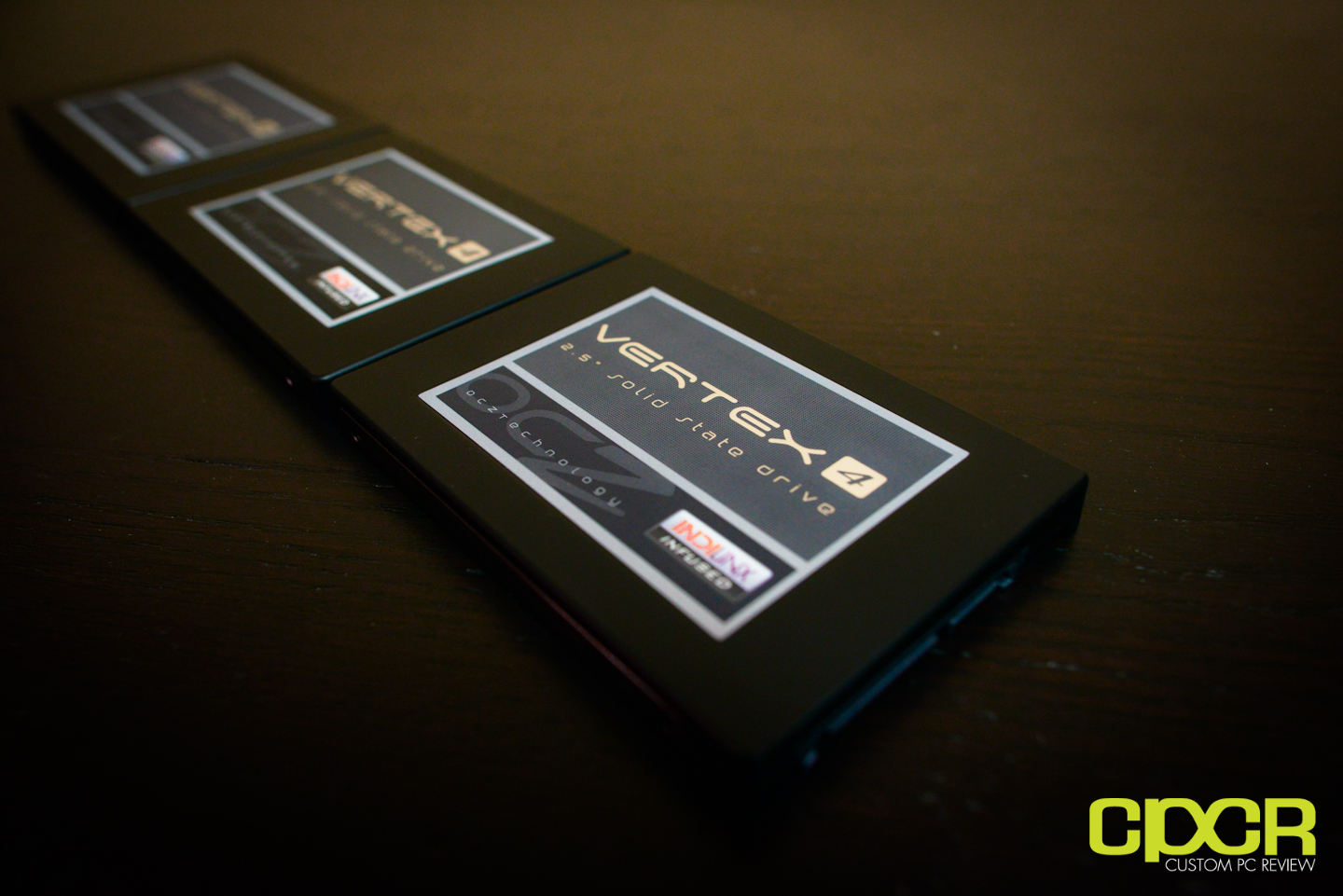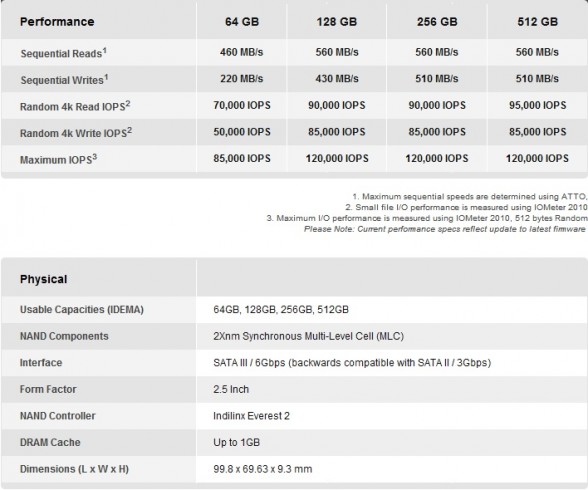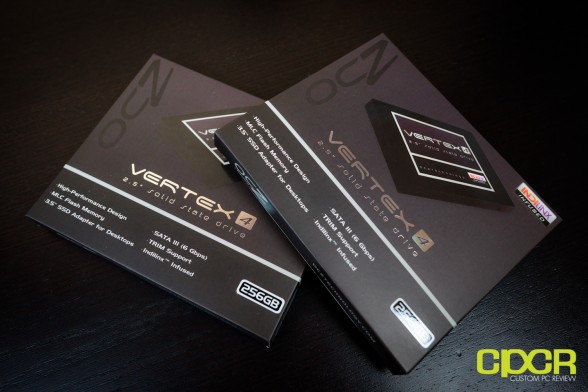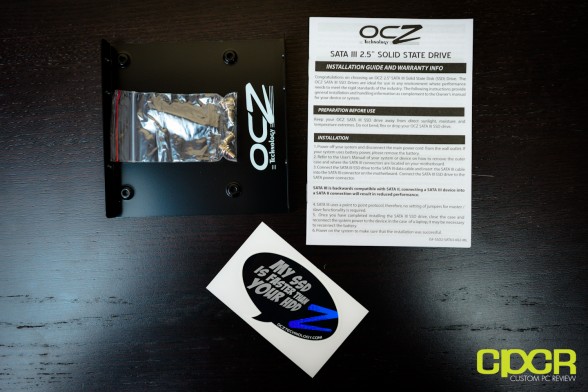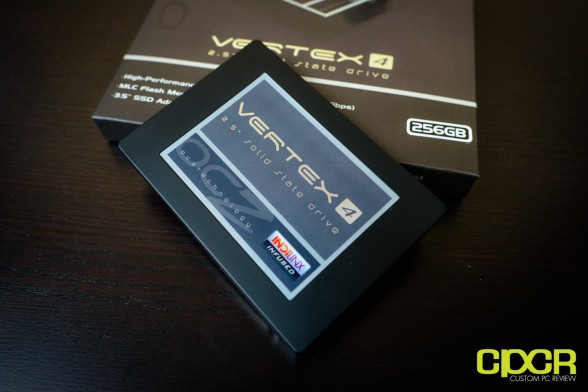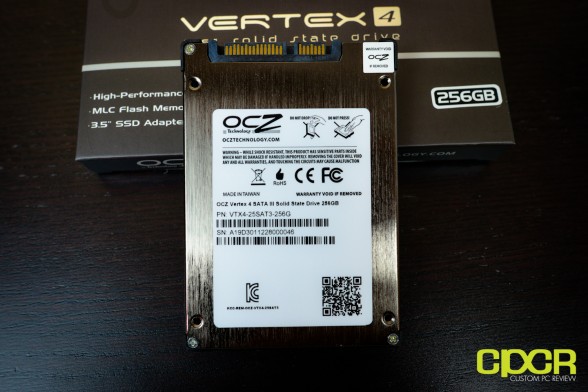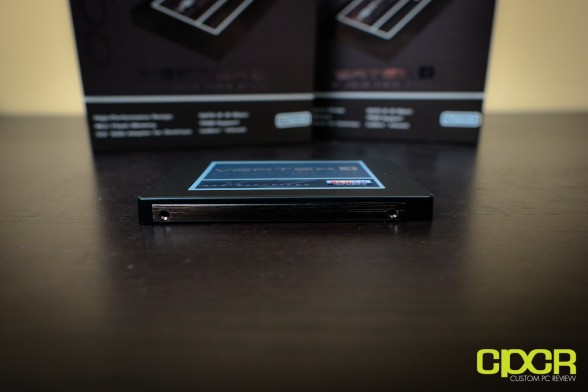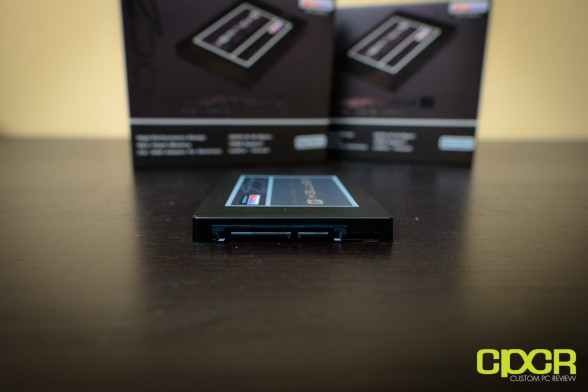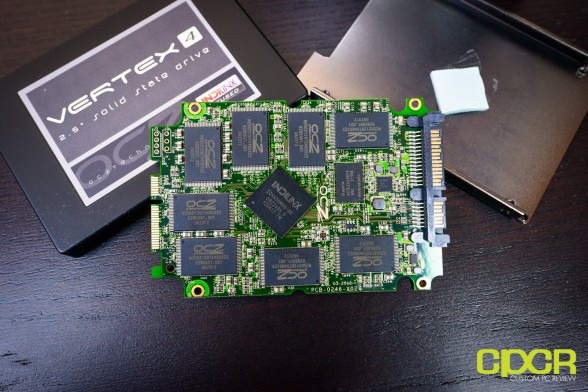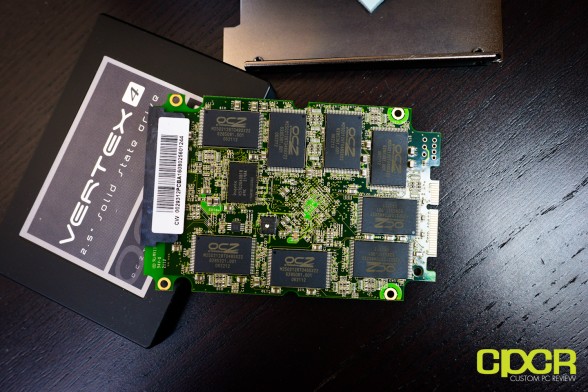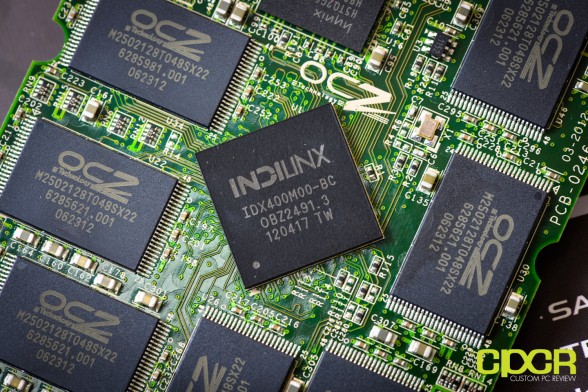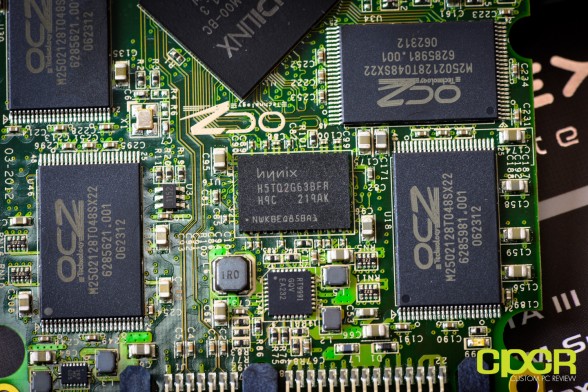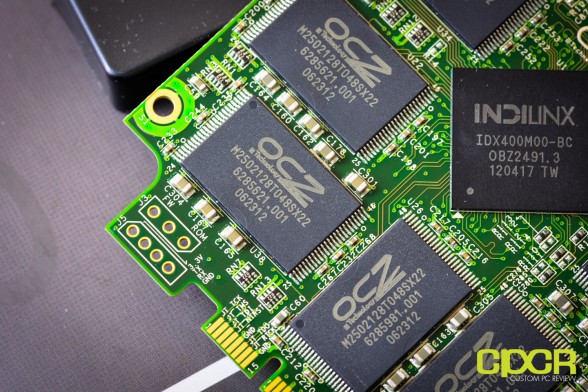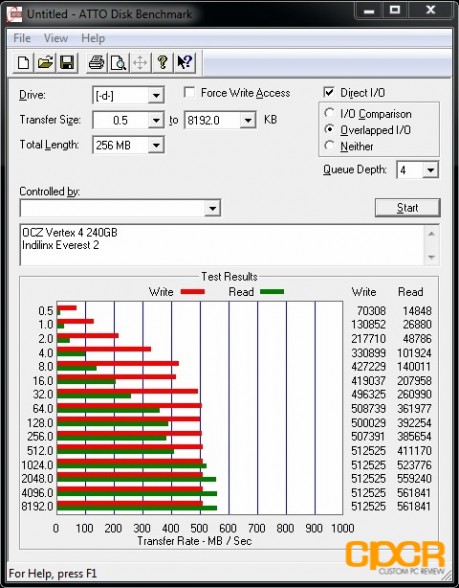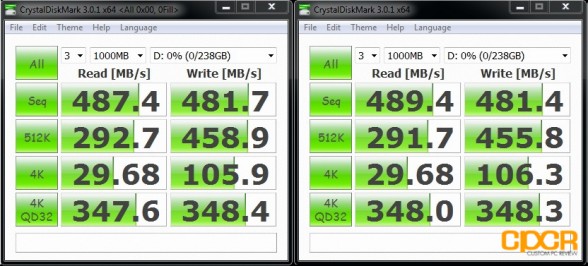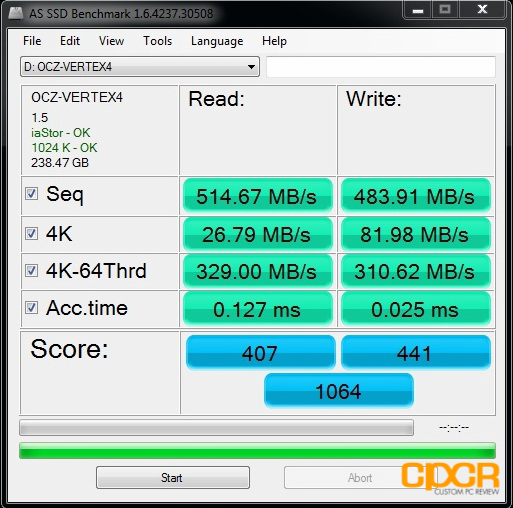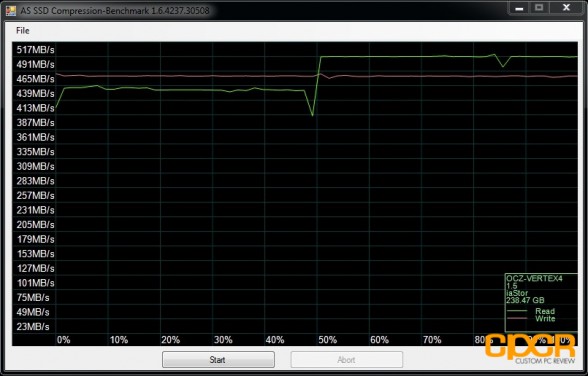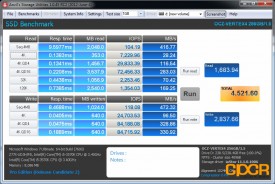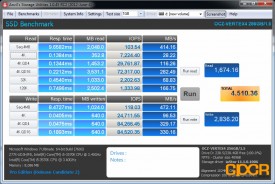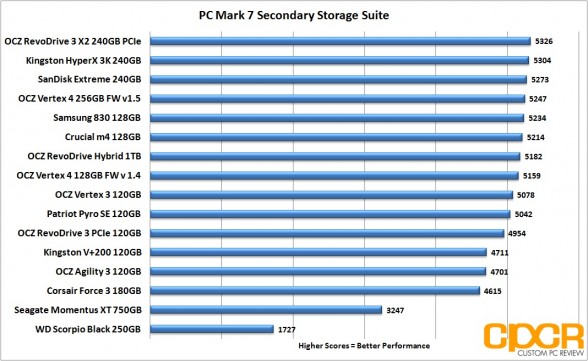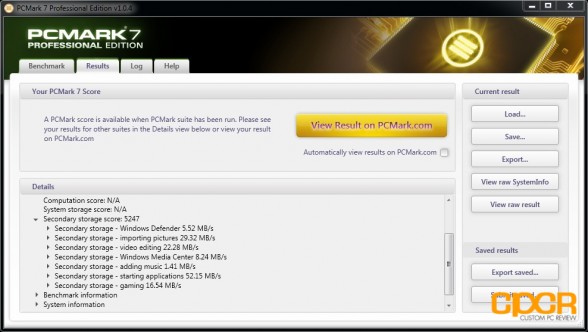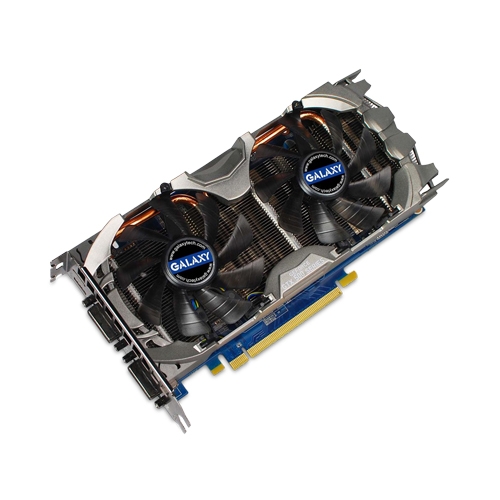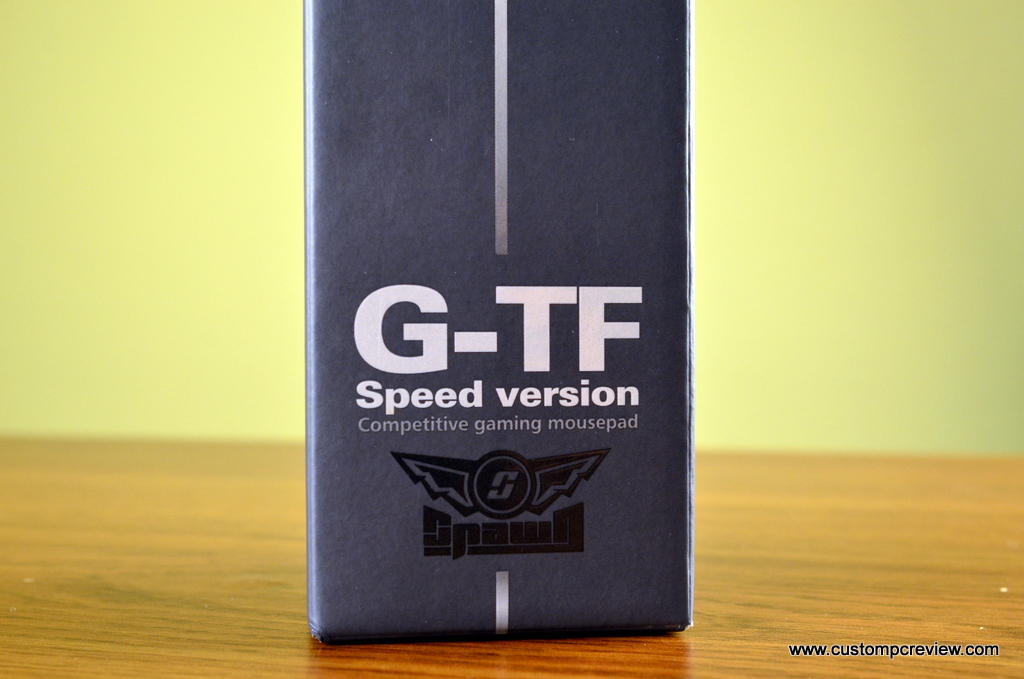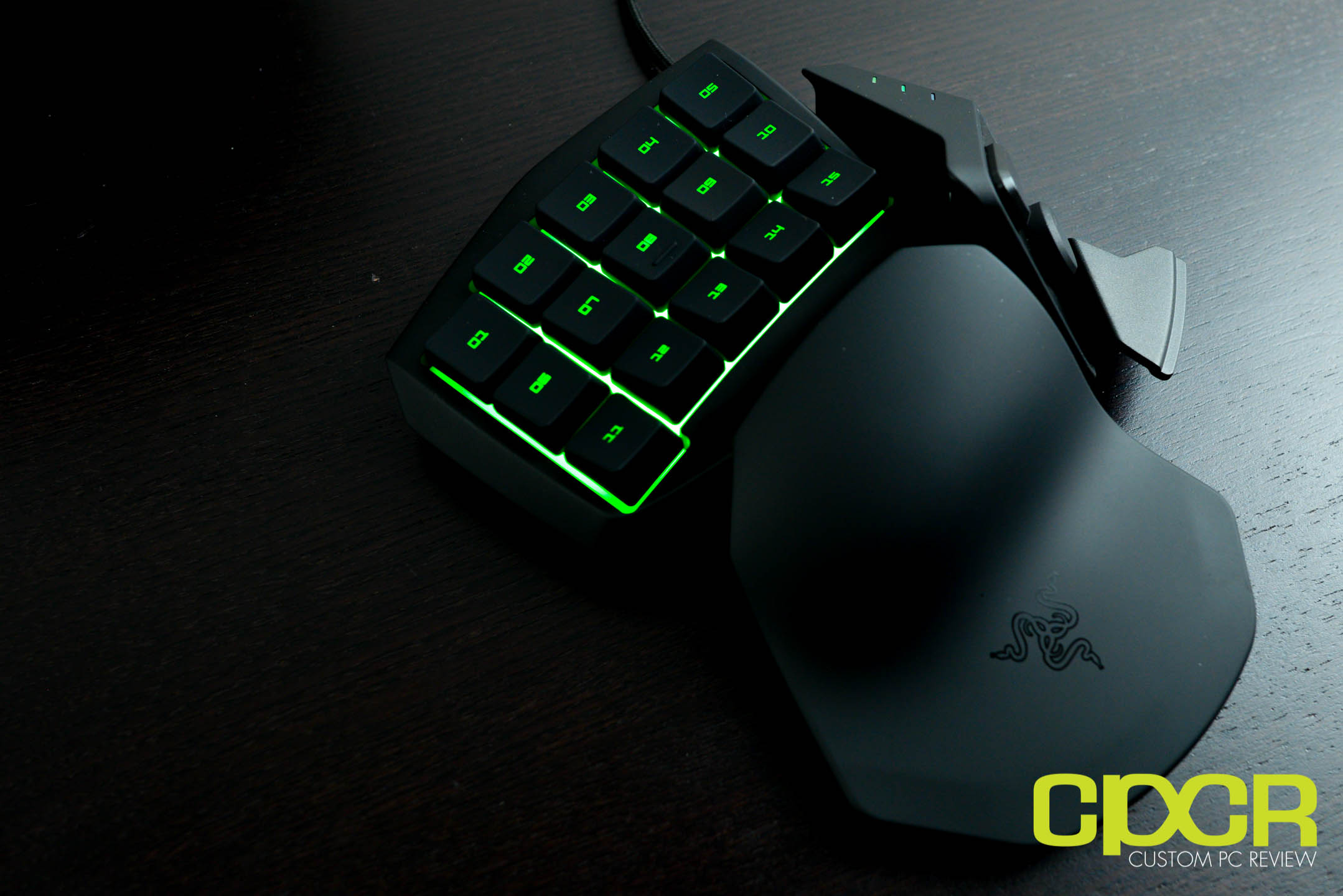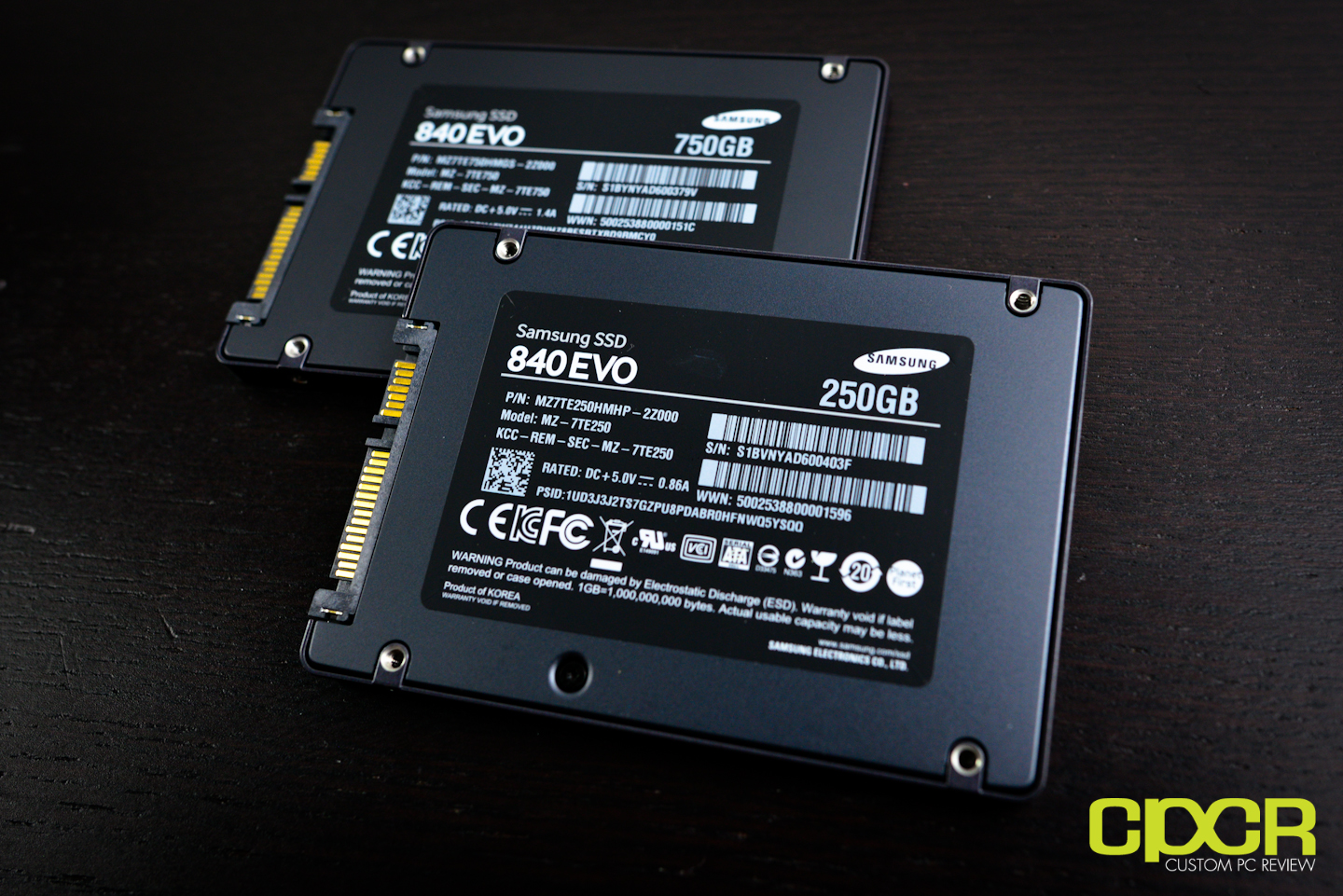[section label=1. Introduction]
New Capacity, New Firmware, New Vertex of Performance
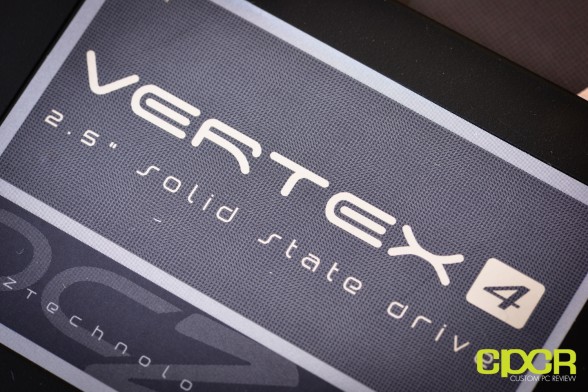 Only a couple weeks ago we took a look at the OCZ Vertex 4 128GB and we were extremely impressed with the direction OCZ was moving in with the Vertex line of SSDs. Today, we’ll be revisiting that review by reviewing a different capacity of the OCZ Vertex 4 SSD, the 256GB edition.
Only a couple weeks ago we took a look at the OCZ Vertex 4 128GB and we were extremely impressed with the direction OCZ was moving in with the Vertex line of SSDs. Today, we’ll be revisiting that review by reviewing a different capacity of the OCZ Vertex 4 SSD, the 256GB edition.
The reason for this review is two-fold. The first is that typically with 256GB SSDs, we see better performance especially in writes likely due to the higher density of memory per channel. With prices dropping on the 256GB edition drives to much more affordable levels for general consumers, the better performance often found on 240GB/256GB drives may sway users to spend the extra on a faster, larger capacity drive instead.
The second reason is to get an idea of what kind of additional performance benefits OCZ was able to crank out with firmware version 1.5 which was released only a couple weeks ago. With OCZ’s shift to their own Indilinx platform, they’ve had much greater control over the Vertex 4’s firmware than they had with their SandForce based Vertex 3, which they’ve really capitalized on to push significant performance boosts even after the Vertex 4’s initial release.
Specifications
[section label=2. A Closer Look (Exterior)]
A Closer Look at the OCZ Vertex 4 256GB SSD
Since the OCZ Vertex 4 256GB and the OCZ Vertex 4 128GB SSD come in near identical boxes, with identical accessories, and the SSDs themselves look near identical as well, I’ll let the pictures do most of the explaining here. Those interested in learning more, please check out our OCZ Vertex 4 128GB SSD review here.
The OCZ Vertex 4 box. The only difference between this one and the Vertex 4 128GB edition box is the 256GB label on the bottom right of the front cover.
Accessories include a 2.5″ to 3.5″ drive adapter, mounting screws, an OCZ case sticker along with some documentation.
The Vertex 4 comes in the standard 2.5″ formfactor. The top of the drive is constructed of high quality plastic while the bottom is constructed of metal.
At the bottom we get a OCZ sticker with the model number, serial number, as well as other identifying information. The drive is held together via four screws with one of the screws being covered with a warranty void if removed sticker.
Along the side of the Vertex 4 we get the standard mounting holes typically used for notebooks.
Here’s a look at the SATA 3 6Gb/s port along with the SATA power port. To take advantage of the full performance of this drive, be sure to connect it to a SATA 3 6Gb/s port. That said, it will be compatible with any standard SATA port.
[section label=3. A Closer Look (Interior)]
A Closer Look at the OCZ Vertex 4 256GB SSD
Opening up the 256GB Vertex 4, it seems like OCZ is now rebranding the NAND chips inside to show OCZ instead of the third party the NAND was sourced from.
Taking a look at both the front and the back, it seems like OCZ is still using the sixteen 25nm synchronous MLC NAND module configuration except with this specific drive carrying a capacity of 256GB, each NAND module should hold 16GB.
The centerpiece of the Vertex 4 of course is the Indilinx Everest 2 controller, which as we’ve touched on before is simply a rebadged and overclocked Marvell controller running OCZ’s Indilinx firmware.
Unlike the Vertex 4 128GB SSD which had Micron DRAM modules, OCZ is sourcing the two 256MB DRAM buffer cache modules on this particular 256GB Vertex 4 from Hynix. I wouldn’t be surprised if some Vertex 4’s came with Hynix modules and some with Micron modules.
Here’s a closer look at some of the OCZ branded 25nm synchronous MLC NAND modules onboard. Because of the OCZ branding, it’s not 100% clear to me where OCZ’s sourcing these modules from, but my best guess would be Intel/Micron (IMFT).
[section label=4. ATTO Disk Bench]
Ivy Bridge Test Bench
CPU: Intel Core i5 3570K
Motherboard: Gigabyte Z77X-UD3H
Graphics: Intel HD4000 Graphics
Memory: Corsair Vengeance DDR3 1600MHz Low Profile
Storage: Patriot Pyro SE 120gb
Power Supply: Corsair HX650
Case: HSPC High Speed Tech Station
OS: Windows 7 Ultimate x64 SP1
Special thanks to Gigabyte, Kingston, and HSPC for sponsoring our test bench!
OCZ Vertex 4 Performance
Firmware v1.5
Ever since the release of the Vertex 4 back in April, OCZ has been hard at work improving upon the firmware, simultaneously giving Vertex 4 owners both increases in performance and stability along the way. When we did our review of the Vertex 4 128GB back in early June, OCZ had already released firmware v1.4, which brought the Vertex 4 128GB from the 535MB/s sequential reads and 200MB/s sequential writes up to 550MB/s sequential reads and 420MB/s sequential writes, which is a massive jump in terms of sequential reads. During this firmware update, the Vertex 4 256GB also received a significant improvement on the sequential writes, going from 380MB/s sequential writes to 465MB/s sequential writes.
Now enter firmware v1.5 which is what we’ll be testing today. The new firmware update now brings the 256GB Vertex 4 to 560MB/s sequential reads from 550MB/s, and 510MB/s sequential writes from 465MB/s. Since firmware v1.3, the 256GB Vertex 4 has gained a performance improvement of 25MB/s (~5%) sequential reads and a whopping 130MB/s (~34%) sequential writes!
ATTO Disk Benchmark v2.46
ATTO Disk Benchmark is one of the industry’s oldest and most popular benchmarks for testing disk read/write speeds. This benchmarks allows read and write testing using predefined block sizes and gives us a good idea of read/write speeds with different sized files. Most SSD manufacturers these days prefer using this benchmark when advertising SSDs as it tests using compressible data, which tends to yield better performance.
As advertised for firmware v1.5, the Vertex 4 256GB is capable of reaching a whopping 561MB/s sequential reads and 512MB/s sequential writes. What’s surprising about these numbers is that the 500MB/s+ sequential writes being pushed by the Vertex 4 256GB is typically NOT seen on any non-SandForce based consumer level SSD.
[section label=5. Crystal Disk Mark / AS SSD]
Performance
Crystal Disk Mark 3.0.1 x64
Crystal Disk Mark is another popular benchmark which allows us to measure both sequential read/write speeds as well as random read/write speeds. With this benchmark, tests can be run using both random fill (incompressible data) and 0 fill (compressible data). Realistically in typical computer usage scenarios, data being transferred will consist of a mixture of both incompressible and compressible data.
In Crystal Disk Mark, we’re again looking at some phenomenal performance as the Vertex 4 is capable of maintaining its speed in both incompressible and compressible data tests. While 4k reads aren’t that great, the 4k write performance on this drive is the fastest we’ve seen on any SATA based SSD yet.
AS SSD Benchmark
AS SSD is a very commonly used benchmark used to measure SSD performance in a number of categories. Here, tests are run using incompressible data, which most simulate real world usage. It also outputs a final score at the conclusion of the test based off the read and write performance of the drive.
Whereas the AS SSD benchmark is pretty much going to be a repeat of Crystal Disk Mark, the nice thing about AS SSD is that it includes a compression benchmark that gives us a look at how read and write performance changes as data become more compressible. What we’re seeing here is that sequential reads are extremely consistent across both compressible and incompressible data while sequential writes seem to get a huge boost in performance as soon as compression hits about 50%.
[section label=6. Anvil Storage Utilities / PC Mark 7]
Performance
Anvil Storage Utilities
Anvil Storage Utilities is an excellent all around benchmark for testing many different functions of SSD performance. For our purposes, we ran the benchmark through both 0 fill mode (compressible data) on the left and 100% compression (incompressible data) on the right.
Anvil Storage Utilities is a benchmark utility that you might not have seen used previously as we’ve recently added it to our benchmarking suite. What’s great about the utility is that it’s capable of providing us a lot of information on SSD performance such as response times, transfer rates and IOPS figures in an easy to read, easy to use interface.
Overall looking at both the compressible and incompressible numbers, there really isn’t much of a difference. Similar to what we saw in other benchmarks, 4k writes are off the charts and incompressible sequential reads and writes are definitely respectable to say the least.
PC Mark 7
The PC Mark 7 storage test tests the SSD under many different real world tests such as gaming, video editing, etc. This is most representative of the SSD’s performance under real world situations.
In PC Mark 7, we can see that the Vertex 4 performs quite well here as well, out-scoring its older brother the Vertex 3 by a healthy margin. Unfortunately, it comes in with the lowest score among the 240GB/256GB drives, but this is most likely due to the slightly slower read speeds on the Vertex 4.
[section label=8. Conclusion]
OCZ Vertex 4 256GB SSD Conclusions
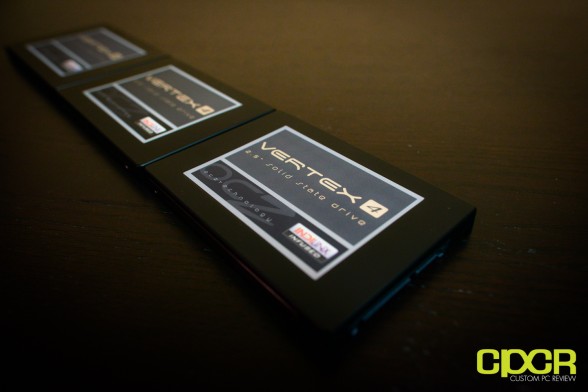 Since this is a revisited review, I’ll mostly be talking about performance and value. Those interested in more information about the Vertex 4, be sure to read our review of the Vertex 4 128GB SSD as well.
Since this is a revisited review, I’ll mostly be talking about performance and value. Those interested in more information about the Vertex 4, be sure to read our review of the Vertex 4 128GB SSD as well.
Taking a look at performance then, OCZ’s Vertex 4 256GB like its little brother, the 128GB edition, simply does not disappoint. In fact, it ‘s not only excellent, it just so happens to also be one of the highest performing SSDs on the market today, rocking the highest incompressible write speeds we’ve ever seen to date on a SATA based SSD. This is undoubtedly due to OCZ’s release of two firmware updates which gave the Vertex 4 nearly a 35% increase in sequential write performance! Despite such significant increases in performance however, OCZ has hinted at a Firmware v1.6, which is supposed to push performance boundary on the already blazing fast Vertex 4 even further.
What does this mean for those of you who are interested in purchasing the Vertex 4? Well those who do lots of incompressible write operations would benefit most from this drive. This means those who do lots of workstation oriented tasks such as photo editing, video editing, audio recording, 3D graphics etc. Given that the Vertex 4 is powerful even in this regard, those looking for something just for a notebook on the go or a fast drive for a gaming machine would find the Vertex 4 more than enough as well.
Current pricing on the Vertex 4 256GB is $209.99 at Amazon, putting the cost of the Vertex 4 256GB among the lowest of the top tier SSDs in terms of price per gigabyte ratios on the market. Comparable SSDs include the Kingston HyperX 3k 240GB ($216.99), Samsung 830 256GB ($229.99), Intel 520 240GB ($269.99), and the Crucial m4 256GB ($203.84). In comparison to these alternatives, only the Crucial m4 256GB comes in at a lower price point; however, of these drives only the Vertex 4 and the Intel 520 come with a 5 year warranty. While many SSD manufactures boast the reliability of their SSDs, Intel and OCZ are actually backing up their claims with an extended warranty.
Bottom Line
With its amazing performance, low cost, a five year industry leading warranty, and OCZ’s commitment to pushing out firmware updates to make the drive even faster and more stable in the long term, the OCZ Vertex 4 256GB is currently one of the best SSDs to buy this year.
Special thanks to OCZ Technology for making this review possible.
The OCZ Vertex 4 256GB is currently available for purchase on Amazon.

